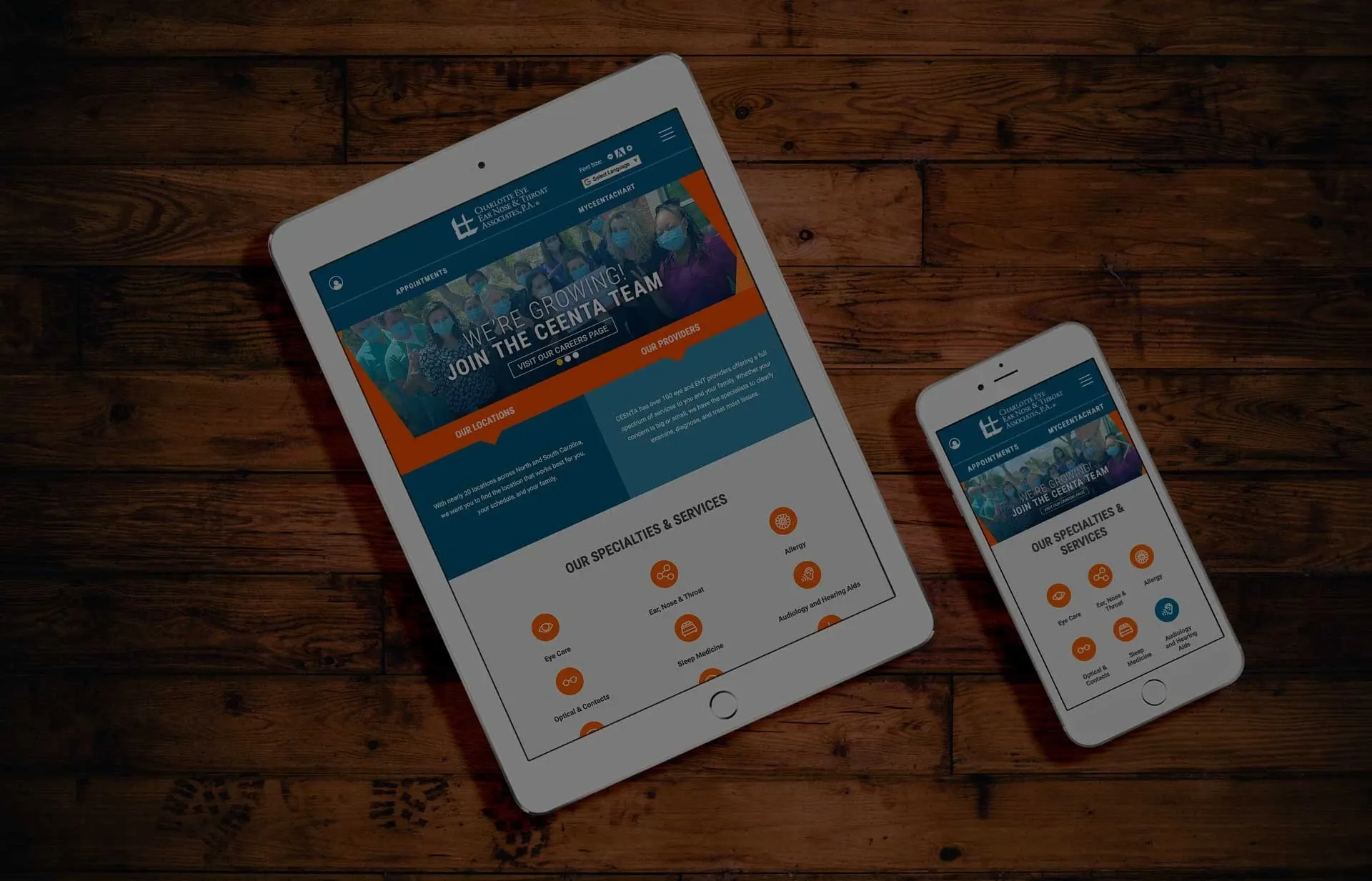If you're trying to build your ophthalmology practice, you know how daunting the task can be. 38.5% of Americans have not visited their eye doctor within the last year, so it's not always at the forefront of people's minds.
Fortunately, there are ways to draw attention to your practice, and many of them are free! Let's talk about the different types of ophthalmology marketing and how to use them in your strategy.
Types of Marketing in the Healthcare Industry
Before we start, why is healthcare marketing so important? Marketing is essential in every industry, but in healthcare, it's arguably more important. Ophthalmology is a great example.
There's typically a narrow window between people thinking about finding an eye doctor and finding one. Finding them in that window can be quite competitive, but it's not impossible. Without using a proper marketing strategy, you aren't competing at all.
While there are far too many types of campaigns to cover in one article, we can break them up into two categories. Here are the most important types of healthcare marketing!
Digital Marketing
There are many forms of digital marketing, and there's no reason to choose just one or two. Social media, email, search engines, directories, notifications, and paid ads can all play a huge role in your marketing strategy.
81% of the US is online daily, and nearly a third are on constantly throughout the day. Without a question, digital marketing is the best way to expand your reach, especially with such a wide array of options. However, they aren't the only aspect to worry about.
Physical Marketing
Physical marketing is what you do offline. This includes everything from your flyers and direct mail campaigns to how you interact with your patients. Positive interactions drive word-of-mouth marketing, which is the most effective form, and a repeat patient base.
Did you know that 88% of consumers trust their friends' recommendations over traditional media? Essentially, how you run your practice is arguably the most important form of marketing there is. A clean environment, friendly staff, and great experience will go a long way.
There are also plenty of other physical marketing campaigns to choose from. However, we will primarily focus on digital marketing, as you have the most control over it!
Ophthalmology Marketing 101
Now that you know the different types of marketing for the healthcare industry, let's discuss how to put them to use. Here's a helpful guide for ophthalmology marketing in 2022!
Build a Strong Website
Without a doubt, your website is the center of your entire ophthalmology marketing strategy. Where do your ads, social, email, and search engine efforts attempt to direct traffic? Directing them is one half of the battle, retaining them and converting them is the other half.
Moreover, if users can't quickly navigate through your website, they will leave. Have you ever had a poor experience with a website when you were hoping to find something specific? Did you stay for long?
A strong, user-friendly website is the only way to ensure you don't lose too many potential patients. If users are unsure of how to get from Point A to Point B, they will typically find another source. Having fast loading times, a clear navigation system, and a legible page structure is the only real solution.
With the help of quality web development services, you can get a major headstart on your marketing strategy. Anything you do to improve the quality of your website will produce dividends for your marketing efforts as a whole.
Use SEO in Your Strategy
Once you have a strong website, you can immediately go to work on your SEO strategy. This is the best driver of organic traffic on the web, so use it to your advantage.
More importantly, SEO strategies take time to build. This is not a short-term revenue builder like PPC ads. For this reason, it's best to start as early as possible.
Develop a list of keywords that you want to rank for, build a strong website, and manage your online reputation. These are the three essential components of any SEO strategy.
For finding keywords, brainstorm and type in your shortlist into an online keyword research tool. This will give you related keywords with their relative search volume, competition, and cost per click. Ideally, you want to find and prioritize keywords with the lowest competition-search volume ratio possible.
From there, diversify your strategy over time. Use as many related keywords as you can, but only when you can use them organically. Don't keyword stuff!
Launch a Blog
Every website needs a blog to compete in today's world. This is the best way to diversify your SEO strategy by offering answers to as many potential questions as possible. Then, when users find you, you can easily convert them to patients.
For example, ranking for keywords like "eye doctor near me" or "how to renew my glasses prescription" can help drive relevant traffic to your site. While these are only two examples, your options are truly endless.
If your content is engaging and informative, you can easily end with a "call to action" (CTA) to convert readers into patients. A few examples at the end of your blog article could be:
- "Stay up to date with our latest health tips, and contact us with any questions."
- "Keep reading our blog for our latest eye care tips, and schedule an appointment today!"
- "Always use the right prescription for your needs, and check out our services if you need help!"
In these examples, you can easily use "contact us," "schedule an appointment," or "our services" as anchor texts. From there, you can link users to the next intended step of the journey. Essentially, you want to offer them the information they need and position your services as the solution.
Head Off the Page
While your website is essential, most of your first impressions will take place off of your website. Marketing starts by drawing traffic there, so how do we do that?
Your mind may immediately go to social media, and you're not far off. However, this is usually a means of retention rather than acquisition. More on that later.
Instead, focus on building a strong online presence where it matters to your industry. These include local healthcare listings, insurance directories, and business directories. Most importantly, Google Maps and Google Business Profile (formerly Google My Business).
Using these will help users find you and help search engines verify that you are who you say you are. These are all quite important for building an online presence. Use them to your advantage wherever applicable.
Drive Short-Term Traffic
Building an organic marketing strategy is highly effective for long-term growth, but it does fall short of building fast revenue. To build short-term traffic to your website, you will need to invest in advertising to some extent.
Fortunately, PPC ad campaigns come with incredible targeting precision. You can find your intended audience with targeted ads for your practice based on their search history, cookie data, and more. This will display your ad to people within your area who are most likely to seek the care of an ophthalmologist.
However, your ad campaigns need optimization and tracking. This includes professional ad creation, A/B testing, and ongoing analytics. Without these components, it's fairly easy to lose money on an ad campaign.
Moreover, this is because a rate of $2 per click with a 0.5% conversion rate means that you'd need to net $400 from each patient just to break even on your campaign. This isn't sustainable in the long run, and there's no telling when your other marketing campaigns will yield a return.
Still, ads are a great way to bridge the gap and drive short-term revenue while building your other marketing strategies. Even then, ads should always have some place in your ongoing efforts!
Diversify Your Means
Nobody wants to rely entirely on paid ads, especially if they're struggling just to break even. Instead, focus on diversifying your organic traffic means. This includes social media, SEO, and more.
The more platforms you use, the better, as long as you can continuously maintain them. If something isn't working, you can drop it, but we recommend sticking to as many as possible. The more available options you have, the easier it will be to ween off of paid ads.
Use directory listings, business profiles, healthcare networks, and more. These can all directly impact your bottom line, and most of them are entirely free. Also, strong reputation management will help boost your SEO strategy!
Don't Forget About Retention
Retention isn't something emergency departments want to build. However, ophthalmologists thrive when they have loyal patients. For this reason, every ophthalmologist should use email marketing to some extent, even for small practices.
Of course, social media, notifications, and direct mail are great ways to build a loyal patient base. However, almost everyone checks their email daily, giving it an important advantage.
Even if you only send newsletters once every 3 to 6 months, it can still remind your patients to book a follow-up appointment when they need it. You can also automate your email marketing campaigns to make them easier! Then, you can just set it and forget it.
This way, 6 months or a year after a patient's visit, they can get a personalized reminder email to book another appointment with you. Getting patients is half of the marketing battle. Keeping them is the other half.
Not convinced? Well, a 5% increase in customer retention results in up to 95% profit increases. It pays to keep your patients!
Talk to Your Patients
There's no harm in asking your patients to give you a "like" on social media, review you on Google, or tell their friends about your practice. If you're just starting, talk to your most loyal patients and leave a sign somewhere in your practice to prompt this engagement. You never know how positive the responses can be until you try!
This is a great way to combine both physical and digital marketing. Offer your patients a quality experience and ask them to share their experiences with others in one way or another.
Hire Professional Healthcare Marketing Services
A poor marketing campaign can turn into a financial drain with the rising costs of digital ads. Also, a DIY website can stand out in an online world dominated by tech giants. Unfortunately, this leaves no room for error.
However, with the right professional healthcare marketing services, you can benefit from the industry expertise you need and save money in the long run. Every boost to your marketing campaign now will save you a small fortune later on. The better your initial footing, the less you will have to fix later on.
Also, some of these strategies take time to build. If you're trying to build them yourself without any experience, there's a sharp learning curve. The last thing you want to do is play a "guessing game" for months and not reap any rewards from it.
For these reasons and more, there's no better way to set your practice up for success than with professional help.
Launch Your Strategy Today
Now that you know more about ophthalmology marketing, put these tips to good use today. No industry is immune from the need for quality marketing, so start expanding your list of patients, and don't forget to keep them on the hook!
Keep reading our blog for our latest digital marketing tips, and don't hesitate to contact us with any questions or for help with your marketing strategy!
« Back to Blog
Ready to Get Started? Contact Us Today to Schedule Your Discovery.

© 2025. All rights reserved. E-dreamz, Inc.

